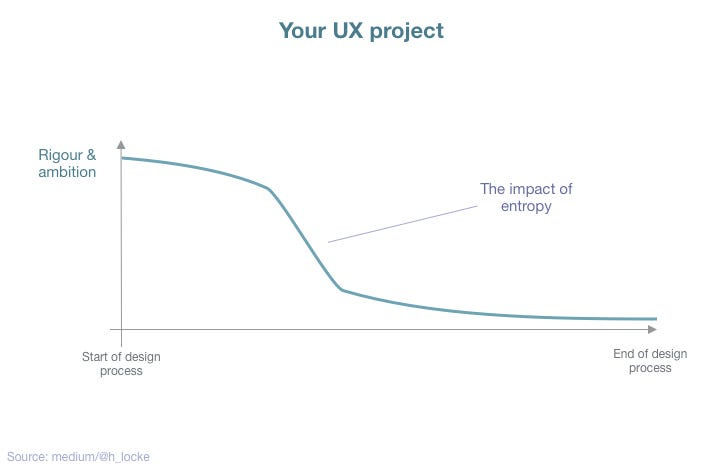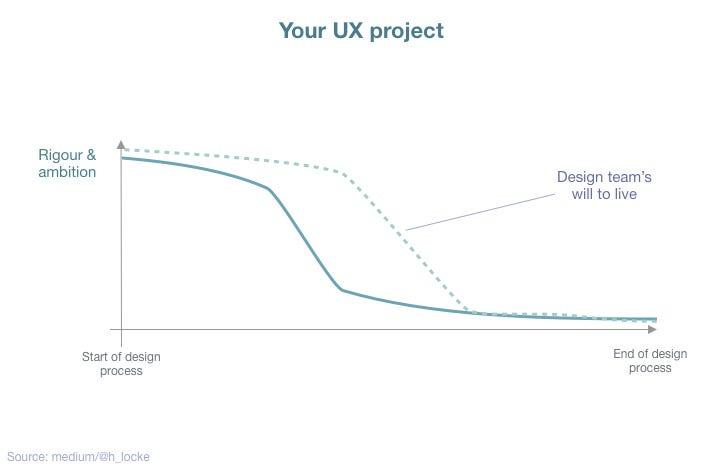What it is and why it’s happening

It is well known among people who have been in the industry a while, or those who review CVs and case studies as part of their job, that what the UX team designs is often not what goes live.
No matter the process and methodology involved, the final UI or design solution in the portfolio often looks somewhat if not very different from the live product. Or the product 2 years post-launch.
What the UX team designs is often not what goes live
We are often told that UX work involves “pragmatism” and it does. We have to be realistic and flexible in the face of our clients’ business needs, the research budget, the timings, the technical capabilities available etc. But when exactly does pragmatism end and “giving in” begin?
An industry of disappointment?
New UX people I meet who are emerging from a Course, University or Bootcamp seems to have a similar experiences these days — they are taught of this magical good-doing UX World, where the process unfolds seamlessly before you like some heavenly, well-organised path of righteous user-centred deliverables.
I usually get a call around 4 weeks into their new job. “We’re not doing personas.. we’re not doing research.. we’re not following the process”.
There are often very good reasons for this — size of company, type of client, type of work. But also, it’s because educational courses don’t have real clients (no, not really), are not subject to real pressures and risks, are not beset on all sides by things that create entropy.
What is entropy?
Entropy. n. A process of degradation or running down or a trend to disorder [source]
The universe is chaos. Life is chaos. Whereas humans seem determined to strive for order; which is the opposite.
We try to control things — get a job, save money, buy a house or own some land — in short, build some level of security. It’s nice to think we are in control, but unfortunately it’s an illusion and a fairly futile fight against the fact that life is chaos and eventually we all die. Sorry.
Similarly, the creation of digital things is complex and the design process is essentially one big attempt to make order out of chaos. It’s an ongoing fight against disorder and degradation.
The design process is an attempt to make order out of chaos
It’s not just entropy of launched and live products
The majority of articles I’ve found (see footer) that reference entropy in the design process are usually talking about a live product that degrades over time due to technical debt or ballooning engineering requirements or decisions that deviate from the original product strategy. And that’s certainly an issue.
If you look back at any website or app that you worked on a couple of years ago, it’s probably changed a lot by now. Even if you had a solid UX strategy at the beginning or at launch, if there was no post-launch governance and guidelines in place for CMS users, you may not even recognise your original work 12 months later.
However there’s another version of UX entropy, and it’s far more dangerous because it happens during the initial UCD process for a new product.
When entropy infiltrates a product design or redesign, it can quickly build momentum resulting in a final product that doesn’t meet user needs, and possibly only meets the needs of one set of stakeholders. I call these the JFDI department.
What does it look like on a project?
You may not realise that entropy is attacking your project, so here are some early signs. If they occur without rational reason or logical justification, you could be at the beginning of an entropy snowball effect.
Challenging or changing the method, budget, or timings
Cutting out research, rigour or other key stages of the process
Making design or project-critical decisions without involving the UX team
Now ideally, you have a design team lead who is used to seeing these signs, can see them coming and can put a stop to it before it demotivates your entire design team. Still, whatever your current career level (and yes, no matter how junior), you may see them earlier so it’s good to be aware. You can support your product or project lead by spotting and flagging snowballs before they become avalanches.
The impact of entropy on project outcomes
So if entropy is part of the world order, why should we care? Well in UX world, entropy on a UCD project means that over time, user needs or user-centred thinking will gradually be eroded to be replaced with business goals or technical expediency — so that what you thought was a great UCD project turns into a JFDI in order to get something shipped.
The result of this happening, over and over again, is the launching of crappy products that don’t answer user needs and decay even further over time post-launch. Not to mention a totally demoralised design and UX team who begin to lose the will to UX.
And as many businesses find out to their detriment, if you systematically put business needs ahead of user needs and ignore the advice of your UX team, then you’ve already destroyed any chance of a successful product.
What causes it?
There are so many things that can impact the successful (or not) outcome of a UX project.
Some are screamingly obvious from the outset of a project. Some sneak in later on even with the best of intentions.
There are some specific issues which may degrade project outcomes even if you have a team that starts out with a clear process, a properly resourced team and the strong desire to do A Good Job For Users.
Keep reading with a 7-day free trial
Subscribe to It Depends... to keep reading this post and get 7 days of free access to the full post archives.





